Chapter 2 Installing R and RStudio
(Notation; installing R and RStudio; packages; first experiments.)
2.1 Overview
2.1.1 Abstract:
This unit works through the installation of R and RStudio on your machine as well as through docker and introduces R's packages of additional functions.
2.1.2 Objectives:
This unit will:
- guide you through first steps for installing R and R Studio on your own computer; and
- guide you through installing and using R and R Studio through docker; and
- introduce the concept of "packages" to extend R's functionality;
2.1.3 Outcomes:
After working through this unit you:
- have a working installation of R and RStudio and know how to start RStudio;
- have a working knowledge of docker and how to use it with R and Rstudio.
- can find and install packages.
2.1.4 Deliverables:
Time management: Before you begin, estimate how long it will take you to complete this unit. Then, record in your course journal: the number of hours you estimated, the number of hours you worked on the unit, and the amount of time that passed between start and completion of this unit.
Journal: Document your progress in your Course Journal. Some tasks may ask you to include specific items in your journal. Don't overlook these.
Insights: If you find something particularly noteworthy about this unit, make a note in your insights! page.
2.1.5 Prerequisites:
This unit builds on material covered in the following prerequisite units:
2.2 R
2.2.1 Introduction
The R statistics environment and programming language is an exceptionally well engineered, free (as in free speech) and free (as in free beer) platform for data manipulation and analysis. The number of functions that are included by default is large, there is a very large number of additional, community-generated analysis modules that can be simply imported from dedicated sites (e.g. the Bioconductor project for molecular biology data), or via the CRAN network, and whatever function is not available can be easily programmed. The ability to filter and manipulate data to prepare it for analysis is an absolute requirement in research-centric fields such as ours, where the strategies for analysis are constantly shifting and prepackaged solutions become obsolete almost faster than they can be developed. Besides numerical analysis, R has very powerful and flexible functions for plotting graphical output.
Note: you can't learn a programming language in a single day.
Work through this material unit by unit, but when you are done, you need constant repetition to bring it into active memory. And make sure you understand every step. Taking shortcuts and/or cramming everything in a single, desperate effort is a waste of your time.
2.2.2 Before you begin: Notation and Formatting
In this tutorial, I use specific notation and formatting to mean different things:
- If you see footnotes1, click on the number to read more.
- This is normal text for explanations. It is written in a proportionally spaced font.
Code formatting is for code examples, file- and function names, directory paths etc. Code is written in a monospaced font2.
for (i in 1:10){
#example code block
}- Bold emphasis and underlining are to mark words as particularly important.
- Examples of the right way to do something are highlighted green.
- Examples of the wrong way to do something are highlighted red.
2.2.3 Task - example
Tasks and exercises are described in boxes with a blue background. It is highly recommended that you do them. You won't be graded on them but they are all content you can add to your journal. If you have problems, you must contact your instructor, or discuss the issue on the mailing list. Don't simply continue. All material builds on previous material, and evaluation is cumulative.
These sections have information about issues I encounter more frequently. They are required reading when you need to troubleshoot problems but also give background information that may be useful to avoid problems in the first place.
2.2.4 "Metasyntactic variables"
When I use notation like <Year> in instructions, you type the year, the whole year and nothing but the year (e.g the four digits 2017). You never type the angle brackets! I use the angle brackets only to indicate that you should not type Year literally, but substitute the correct value. You might encounter this notation as <path>, <filename>, <firstname lastname> and similar. To repeat: if I specify
<your name>... and your name is Elcid Barrett, You type
Elcid Barrett... and not your name or <Elcid Barret> or similar. (Oh the troubles I've seen ...)
The sample code on this page sometimes copies text from the console, and sometimes shows the actual commands only. The > character at the beginning of the line is always just R's input prompt, it tells you that you can type something now - you never actually type > at the beginning of a line. If you read:
> getwd()you need to type:
getwd()If a line starts with [1] or similar, this is R's output on the console.3
The # character marks the following text as a comment which is not executed by R. These are lines that you do not type. They are program output, or comments, not commands.
2.2.5 Characters
Different characters mean different things for computers, and it is important to call them by their right name.
- / ◁ this is a forward-slash. It leans forward in the reading direction.
- \ ◁ this is a backslash. It leans backward in the reading direction.
- ( ) ◁ these are parentheses.
- [ ] ◁ these are (square) brackets.
- < > ◁ these are angle brackets.
- { } ◁ these are (curly) braces.
- " ◁ this, and only this is a quotation mark or double quote. All of these are not: “”„«» . They will break your code. Especially the first two are often automatically inserted by MSWord and hard to distinguish.Never, ever edit code in MS Word. Use R or RStudio. Actually, don't use notepad or TextEdit either.
- ' ◁ this, and only this is a single quote. All of these are not: ‘’‚‹› . They will break your code. Especially the first two are often automatically inserted by MSWord and hard to distinguish.
MSWord is not useful as a code editor.
2.3 The environment
In this section we discuss how to download and install the software, how to configure an R session and how to work in the R environment.
There are many different ways you can use and setup R. By simply installing R you can use it directly but it is highly recommended that you also install and use RStudio which is an Integrate development environment (IDE) for R. You cannot just download RStudio and use it. It requires an installation of R.
You don't need to install R and RStudio though. You can also use R and RStudio through docker. I highly recommend using docker instead
As with many open source projects, R is a constantly evolving language with regular updates. There is a major release once a year with patch releases through out the year. Often scripts and packages will work from one release to the next (ignoring pesky warnings that a package was compiled on a previous version of R is common) but there are exceptions. Some newer packages will only work on the latest version of R so sometimes the choice of upgrading or not using a new package might present themselves. Often, the amount of packages and work that is need to upgrade is not realized until the process has begun. This is where docker demonstrates it most valuable features. You can create a new instance based on the latest release of R and all your needed packages without having to change any of your current settings.
If you want you can skip over installing R and and Rstudio and go directly to install docker. There is no requirement to do both. I would recommend going straight to docker!
2.4 Task 1 - Install R
-
Navigate to CRAN (the Comprehensive R Archive Network) and follow the link to Download R for your computer's operating system.
- You can also use one of the mirror sites, if CRAN is down - for example the mirror site at the University of Toronto. A choice of mirror sites is listed on the R-project homepage.
- Download a precompiled binary (or build) of the R framework to your computer and follow the instructions for installing it. Make sure that the program is the correct one for your version of your operating system.
- Launch R.
- Once you see that R is running correctly, you may quit the program for now.
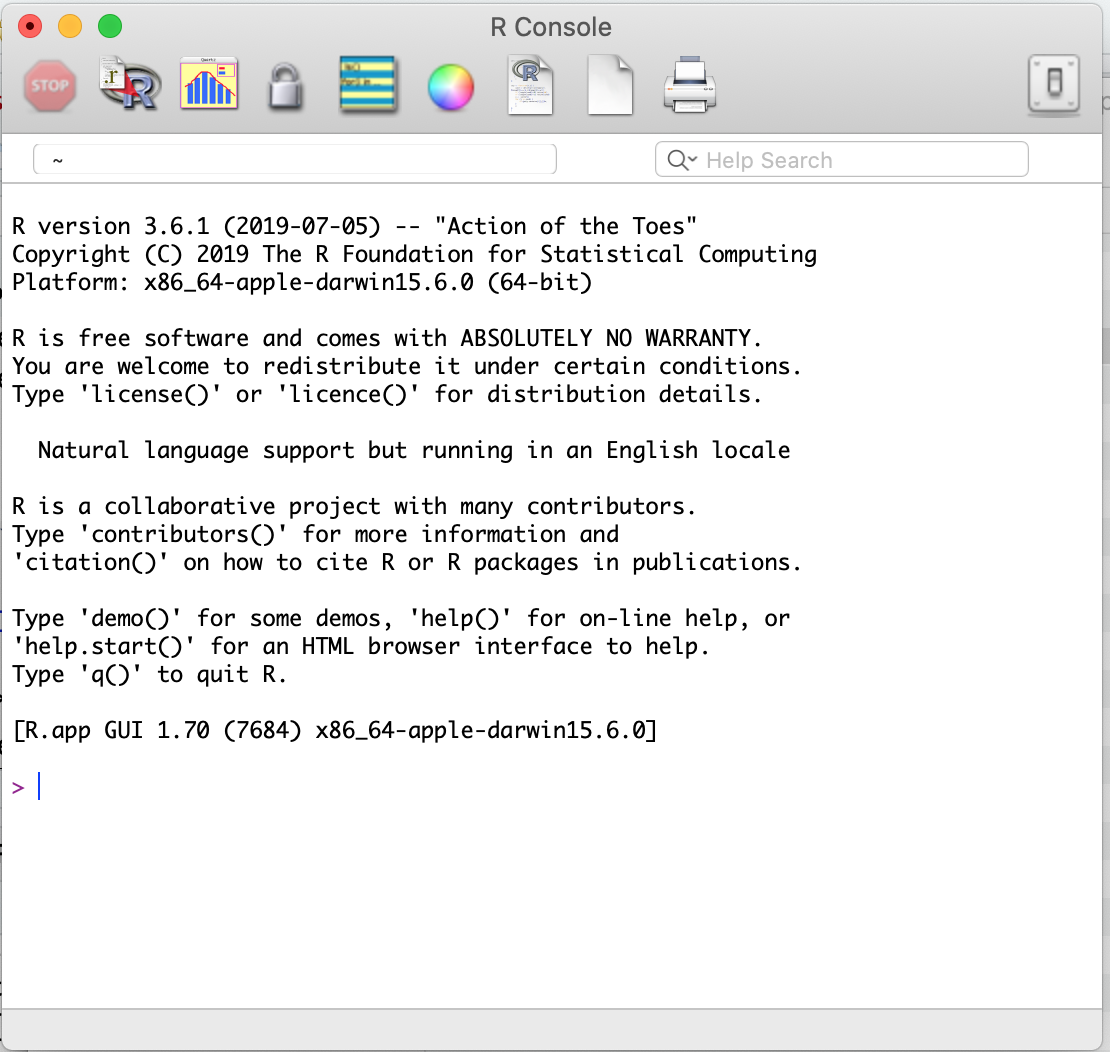
I can't install R.
- Make sure that the version you downloaded is the right one for your operating system.
- Also make sure that you have the necessary permissions on your computer to install new software.
2.5 Task 2 - Install RStudio
RStudio is a free IDE (Integrated Development Environment) for R. RStudio is a wrapper4 for R and as far as basic R is concerned, all the underlying functions are the same, only the user interface is different (and there are a few additional functions that are very useful e.g. for managing projects).
Here is a small list of differences between R and RStudio.
pros (some pretty significant ones actually):
- Integrated version control.
- Support for "projects" that package scripts and other assets.
- Syntax-aware code colouring.
- A consistent interface across all supported platforms. (Base R GUIs are not all the same for e.g. Mac OS X and Windows.)
- Code autocompletion in the script editor. (Depending on your point of view this can be a help or an annoyance. I used to hate it. After using it for a while I find it useful.)
- "Function signaturtes" (a list of named parameters) displayed when you hover over a function name.
- The ability to set breakpoints for debugging in the script editor.
- Support for knitr, and rmarkdown; also support for R notebooks ... (This supports "literate programming" and is actually a big advance in software development)
- Support for R notebooks.
cons (all minor actually):
- The tiled interface uses more desktop space than the windows of the R GUI.
- There are sometimes (rarely) situations where R functions do not behave in exactly the same way in RStudio.
- The supported R version is not always immediately the most recent release.
- Navigate to the RStudio download Website.
- Find the right version of the RStudio Desktop installer for your computer, download it and install the software.
- Open RStudio.
-
Focus on the bottom left pane of the window, this is the "console" pane.
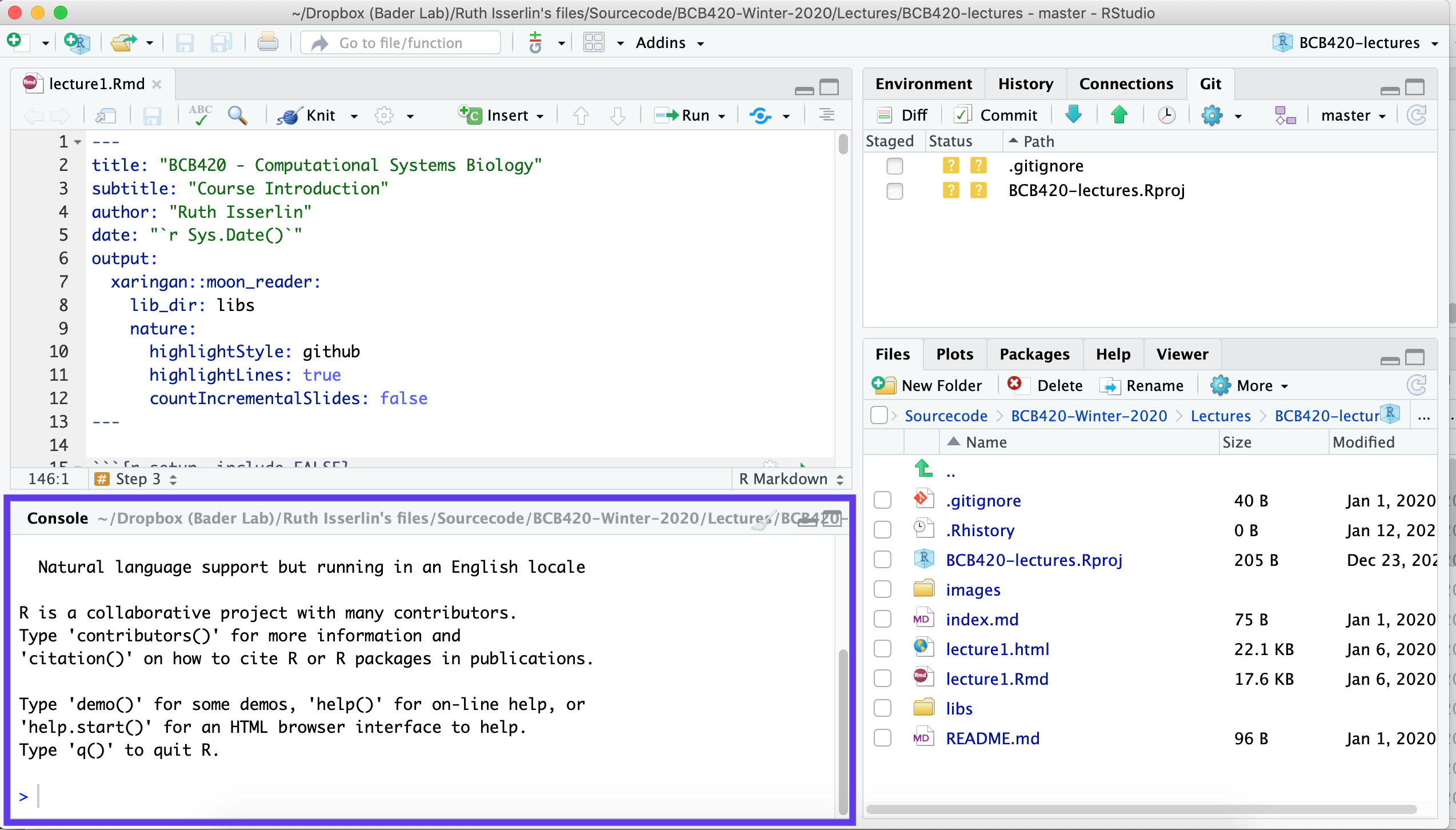
- Type getwd().
- This prints out the path of the current working directory. Make a (mental) note where this is. We usually always need to change this "default directory" to a project directory.
2.6 Docker
Changing versions and environments are a continuing struggle with bioinformatics pipelines and computational pipelines in general. An analysis written and performed a year ago might not run or produce the same results when it is run today. Recording package and system versions or not updating certain packages rarely work in the long run.
One the best solutions to reproducibility issues is containing your workflow or pipeline in its own coding environment where everything from the operating system, programs and packages are defined and can be built from a set of given instructions. There are many systems that offer this type of control including:
"A container is a standard unit of software that packages up code and all its dependencies so the application runs quickly and reliably from one computing environment to another." (“What Is a Container?” n.d.)
Why are containers great for Bioiformatics?
- allows you to create environments to run bioinformatis pipelines.
- create a consistent environment to use for your pipelines.
- test modifications to the pipeline without disrupting your current set up.
- Coming back to an analysis years later and there is no need to install older versions of packages or programming languages. Simply create a container and re-run.
All assignments for this course are expected to compile and run. We will be using the bcb420-base-image:winter2022 docker image to run all or your submitted notebooks. If your notebook runs with no errors and renders your html notebook you will recieve full marks for compilation. It is recommended that you do all your work and assignments using this docker image.
2.6.1 What is docker?
- Docker is a container platform, similar to a virtual machine but better.
- We can run multiple containers on our docker server. A container is an instance of an image. The image is built based on a set of instructions but consists of an operating system, installed programs and packages. (When backing up your computer you might taken an image of it and restored your machine from this image. It the same concept but the image is built based on a set of elementary commands found in your Dockerfile.) - for overview see here
- Often images are built off of previous images with specific additions you need for you pipeline. (For example, for this course we use a base image supplied by bioconductorrelease 3.11 and comes by default with basic Bioconductor packages but it builds on the base R-docker images called rocker.)
2.7 Docker - Basic term definition
2.7.1 Container
- An instance of an image.
- the self-contained running system.
- There can be multiple containers derived from the same image.
2.7.2 Image
- An image contains the blueprint of a container.
- In docker, the image is built from a Dockerfile
2.7.3 Docker Volumes
- Anything written on a container will be erased when the container is erased ( or crashes) but anything written on a filesystem that is separate from the contain will persist even after a container is turned off.
- A volume is a way to assocaited data with a container that will persist even after the container. * maps a drive on the host system to a drive on the container.
- In the above docker run command (that creates our container) the statement:
-v ${PWD}:/home/rstudio/projects- maps the directory ${PWD} to the directory /home/rstudio/projects on the container. Anything saved in /home/rstudio/projects will actually be saved in ${PWD}
- An example:
- I use the following commmand to create my docker container:
docker run -e PASSWORD=changeit --rm \
-v /Users/risserlin/bcb420_code:/home/rstudio/projects \
-p 8787:8787 \
risserlin/bcb420-base-image:winter2022- I create a notebook called task3_bcb420.Rmd and save it in /home/rstudio/projects.
Note: Do not save it in /home/rstudio/ which is the default directory RStudio will start in
- On my host computer, if I go to /Users/risserlin/bcb420_code I will find the file task3_bcb420.Rmd
2.8 Task 3 - Install Docker
- Download and install docker desktop.
- Follow slightly different instructions for Windows or MacOS/Linux
2.8.1 Windows
- it might prompt you to install additional updates (for example - https://docs.Microsoft.com/en-us/windows/wsl/install-win10#step-4---download-the-linux-kernel-update-package) and require multiple restarts of your system or docker.
- launch docker desktop app.
- Open windows Power shell
- navigate to directory on your system where you plan on keeping all your code. For example: C:\USERS\risserlin\bcb420_code
- Run the following command: (the only difference with the windows command is the way the current directory is written. ${PWD} instead of "$(pwd)")
docker run -e PASSWORD=changeit --rm \
-v ${PWD}:/home/rstudio/projects -p 8787:8787 \
risserlin/bcb420-base-image:winter2022
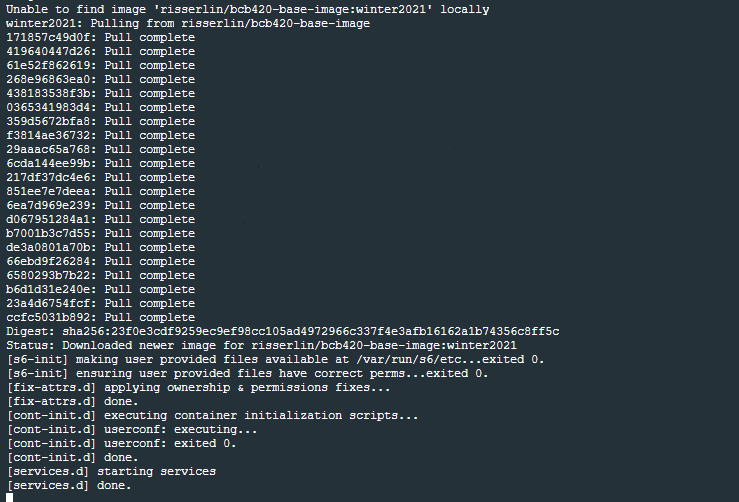
- Windows defender firewall might pop up with warning. Click on Allow access.
- In docker desktop you see all containers you are running and easily manage them.
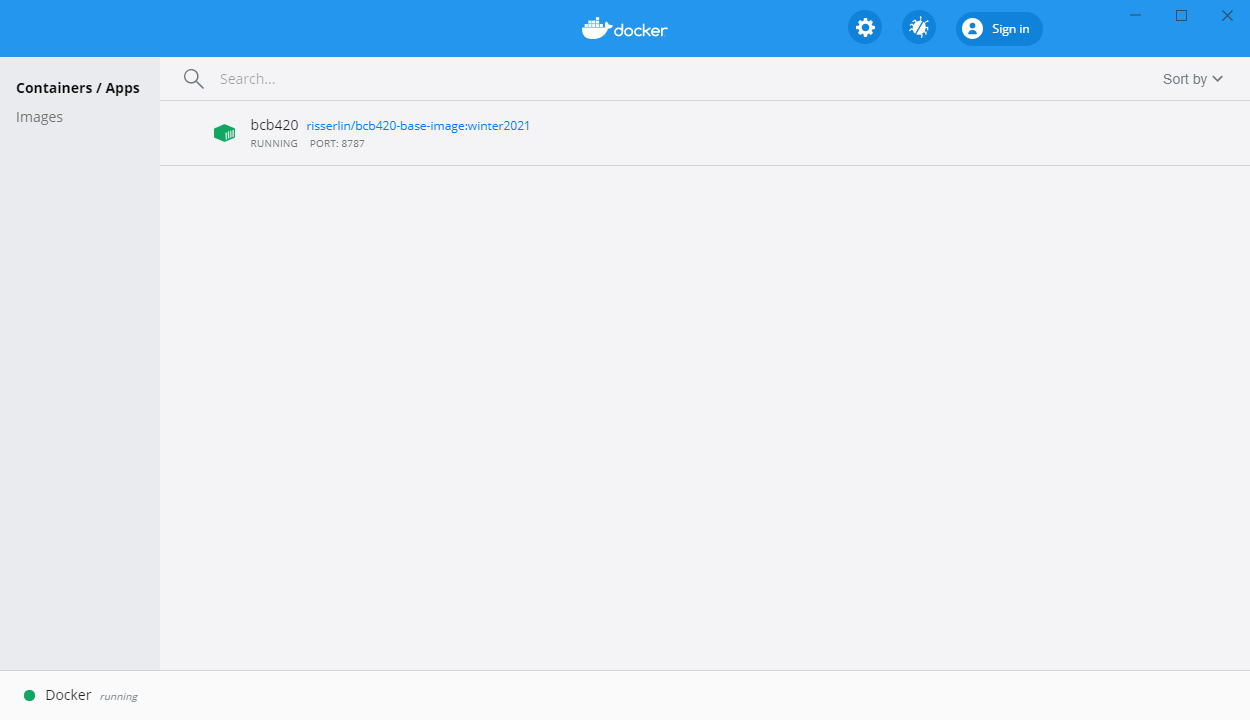
2.8.2 MacOS / Linux
- Open Terminal
- navigate to directory on your system where you plan on keeping all your code. For example: /Users/risserlin/bcb420_code
- Run the following command: (the only difference with the windows command is the way the current directory is written. ${PWD} instead of "$(pwd)")
docker run -e PASSWORD=changeit --rm \
-v "$(pwd)":/home/rstudio/projects -p 8787:8787 \
risserlin/bcb420-base-image:winter2022

2.9 Task 4 - Create your first notebook using Docker
2.9.1 Start coding!
- Open a web browser to localhost:8787

- enter username: rstudio
- enter password: changeit
- changing the parameter -e PASSWORD=changeit in the above docker command will change the password you need to specify
When you go to localhost:8787 all you get is:

- Make sure your docker container is running. (If you rebooted your machine you will need to restart the container on reboot.)
- Make sure you got the right port.
After logging in, you will see an Rstudio window just like when you install it directly on your computer. This RStudio will be running in your docker container and will be a completely separate instance from the one you have installed on your machine (with a different set of packages and potentially versions installed).

Make sure that you have mapped a volume on your computer to a volume in your container so that files you create are also saved on your computer. That way, turning off or deleting your container or image will not effect your files.
- The parameter -v ${PWD}:/home/rstudio/projects maps your current directory (i.e. the directory you are in when launching the container) to the directory /home/rstudio/projects on your container.
- You do not need to use the ${PWD} convention. You can also specify the exact path of the directory you want to map to your container.
- Make sure to save all your scripts and notebooks in the projects directory.
- Create your first notebook in your docker Rstudio.
- Save it.
- Find your newly created file on your computer.
2.10 Packages
R has many powerful functions built in, but one of it's greatest features is that it is easily extensible. Extensions have been written by legions of scientists for many years, most commonly in the R programming language itself, and made available through CRAN–The Comprehensive R Archive Network or through the Bioconductor project.
A package is a collection of code, documentation and (often) sample data. * To use packages, you need to install the package (once). * You can then use all of the package's functions by prefixing them with the package name and a double colon (eg. package::function()); that's the preferred way.
seqinr::bma(c("c","c","a"))- Or you can load all of the package's functions with a library(package) command, and then use the functions without a prefix. That's less typing, but it's also less explicit and you may end up constantly wondering where exactly a particular function came from. In the teaching code for this course, I use the package::function() idiom wherever reasonable.
library(seqinr)
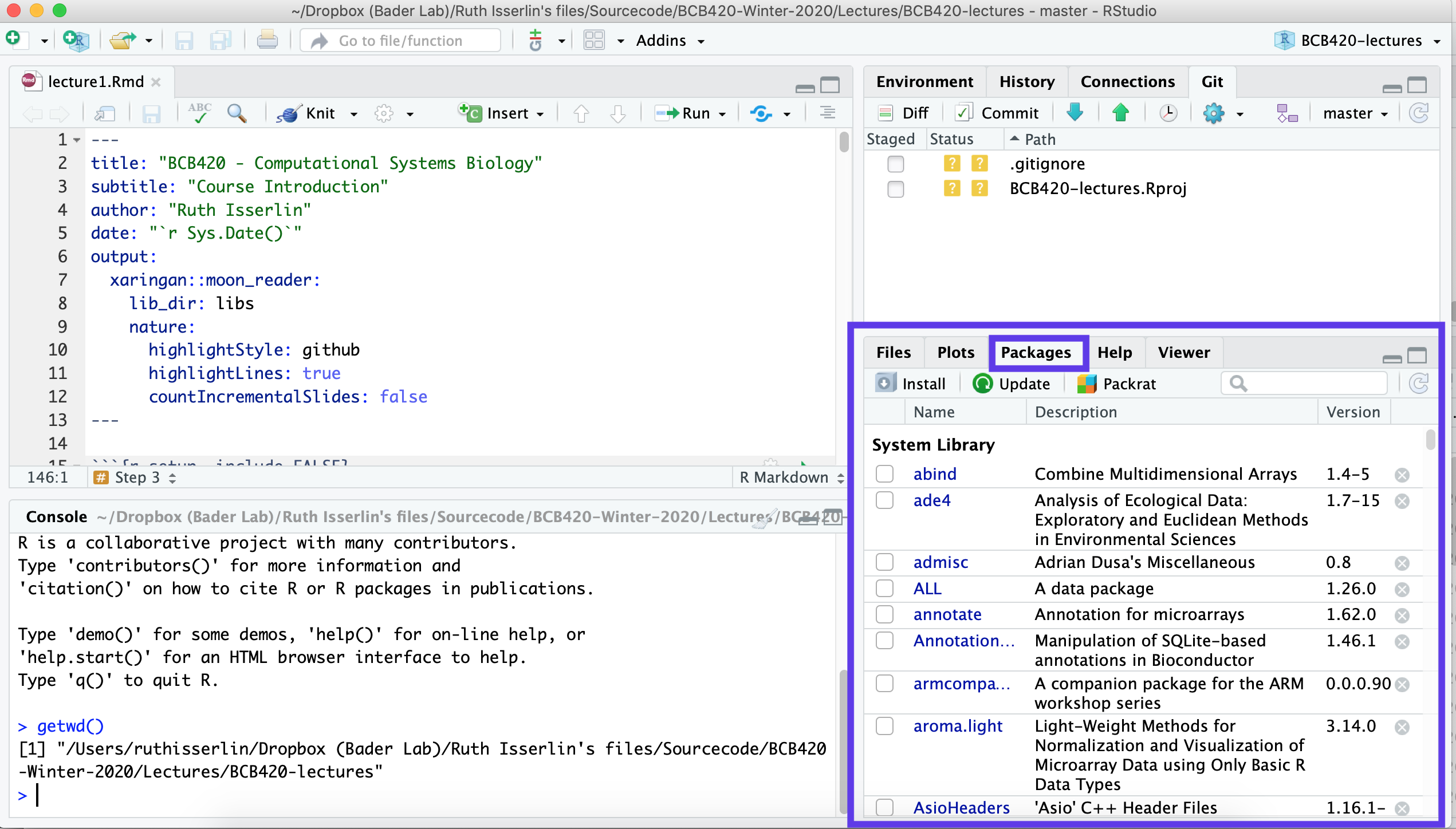
2.11 Task 5 - Experiment with RStudio and packages
- Navigate to http://cran.r-project.org/web/packages/ and read the page.
- Navigate to http://cran.r-project.org/web/views/ (the curated CRAN task-views).
- Follow the link to Genetics and read the synopsis of available packages. The library sequinr sounds useful, but check first whether it has been installed.
- Follow the exercise below
2.11.1 Exercise
In your RStudio window:
- create a new notebook.
- go though each of the commands below and add them to your notebook.
- write your observation for each of commands in the notebook.
Add this new notebook to your github repo and link to it in your journal.
library() opens a window that lists the packages that are installed on your computer;
library()- search() - shows which ones are currently loaded.
search()## [1] ".GlobalEnv" "package:stats" "package:graphics"
## [4] "package:grDevices" "package:utils" "package:datasets"
## [7] "package:methods" "Autoloads" "package:base"- In the Packages tab of the lower-right pane in RStudio, confirm that seqinr is not yet installed.
- Follow the link to seqinr to see what standard information is available with a package. Then follow the link to the Reference manual to access the documentation pdf. This is also sometimes referred to as a "vignette" and contains usage hints and sample code.
- Read the help for vignette. Note that there is a command to extract R sample code from a vignette, to experiment with it.
?vignette- Install seqinr from the closest CRAN mirror and load it for this session. Explore some functions.
# to get help on using install.packages
?install.packages
# Note: the parameter is a quoted string!
install.packages("seqinr",repos="https://cran.rstudio.com/") ##
## The downloaded binary packages are in
## /var/folders/t7/0bt7j4gj4fgfhztd_45bktbm0000gp/T//RtmpMCzNAo/downloaded_packages- this will launch a new window with the seqinr package info
library(help="seqinr") - list all the functions available in the seqinr package.
#Note: the file must be attached in order for the below function to work
library(seqinr)## Warning: package 'seqinr' was built under R version 3.6.2ls("package:seqinr")## [1] "a" "aaa"
## [3] "AAstat" "acnucclose"
## [5] "acnucopen" "al2bp"
## [7] "alllistranks" "alr"
## [9] "amb" "as.alignment"
## [11] "as.matrix.alignment" "as.SeqAcnucWeb"
## [13] "as.SeqFastaAA" "as.SeqFastadna"
## [15] "as.SeqFrag" "autosocket"
## [17] "baselineabif" "bma"
## [19] "c2s" "cai"
## [21] "cfl" "choosebank"
## [23] "circle" "clfcd"
## [25] "clientid" "closebank"
## [27] "col2alpha" "comp"
## [29] "computePI" "con"
## [31] "consensus" "count"
## [33] "countfreelists" "countsubseqs"
## [35] "crelistfromclientdata" "css"
## [37] "dia.bactgensize" "dia.db.growth"
## [39] "dist.alignment" "dotchart.uco"
## [41] "dotPlot" "draw.oriloc"
## [43] "draw.rearranged.oriloc" "draw.recstat"
## [45] "exseq" "extract.breakpoints"
## [47] "extractseqs" "fastacc"
## [49] "gb2fasta" "gbk2g2"
## [51] "gbk2g2.euk" "GC"
## [53] "GC1" "GC2"
## [55] "GC3" "GCpos"
## [57] "get.db.growth" "get.ncbi"
## [59] "getAnnot" "getAnnot.default"
## [61] "getAnnot.list" "getAnnot.logical"
## [63] "getAnnot.qaw" "getAnnot.SeqAcnucWeb"
## [65] "getAnnot.SeqFastaAA" "getAnnot.SeqFastadna"
## [67] "getAttributsocket" "getFrag"
## [69] "getFrag.character" "getFrag.default"
## [71] "getFrag.list" "getFrag.logical"
## [73] "getFrag.qaw" "getFrag.SeqAcnucWeb"
## [75] "getFrag.SeqFastaAA" "getFrag.SeqFastadna"
## [77] "getFrag.SeqFrag" "getKeyword"
## [79] "getKeyword.default" "getKeyword.list"
## [81] "getKeyword.logical" "getKeyword.qaw"
## [83] "getKeyword.SeqAcnucWeb" "getLength"
## [85] "getLength.character" "getLength.default"
## [87] "getLength.list" "getLength.logical"
## [89] "getLength.qaw" "getLength.SeqAcnucWeb"
## [91] "getLength.SeqFastaAA" "getLength.SeqFastadna"
## [93] "getLength.SeqFrag" "getlistrank"
## [95] "getliststate" "getLocation"
## [97] "getLocation.default" "getLocation.list"
## [99] "getLocation.logical" "getLocation.qaw"
## [101] "getLocation.SeqAcnucWeb" "getName"
## [103] "getName.default" "getName.list"
## [105] "getName.logical" "getName.qaw"
## [107] "getName.SeqAcnucWeb" "getName.SeqFastaAA"
## [109] "getName.SeqFastadna" "getName.SeqFrag"
## [111] "getNumber.socket" "getSequence"
## [113] "getSequence.character" "getSequence.default"
## [115] "getSequence.list" "getSequence.logical"
## [117] "getSequence.qaw" "getSequence.SeqAcnucWeb"
## [119] "getSequence.SeqFastaAA" "getSequence.SeqFastadna"
## [121] "getSequence.SeqFrag" "getTrans"
## [123] "getTrans.character" "getTrans.default"
## [125] "getTrans.list" "getTrans.logical"
## [127] "getTrans.qaw" "getTrans.SeqAcnucWeb"
## [129] "getTrans.SeqFastadna" "getTrans.SeqFrag"
## [131] "getType" "gfrag"
## [133] "ghelp" "gln"
## [135] "glr" "gls"
## [137] "is.SeqAcnucWeb" "is.SeqFastaAA"
## [139] "is.SeqFastadna" "is.SeqFrag"
## [141] "isenum" "isn"
## [143] "kaks" "kdb"
## [145] "knowndbs" "lseqinr"
## [147] "modifylist" "move"
## [149] "mv" "n2s"
## [151] "ncbi.fna.url" "ncbi.gbk.url"
## [153] "ncbi.ptt.url" "ncbi.stats"
## [155] "oriloc" "parser.socket"
## [157] "peakabif" "permutation"
## [159] "pga" "plot.SeqAcnucWeb"
## [161] "plotabif" "plotladder"
## [163] "plotPanels" "pmw"
## [165] "prepgetannots" "prettyseq"
## [167] "print.qaw" "print.SeqAcnucWeb"
## [169] "query" "quitacnuc"
## [171] "read.abif" "read.alignment"
## [173] "read.fasta" "readBins"
## [175] "readfirstrec" "readPanels"
## [177] "readsmj" "rearranged.oriloc"
## [179] "recstat" "residuecount"
## [181] "reverse.align" "rho"
## [183] "rot13" "s2c"
## [185] "s2n" "savelist"
## [187] "SEQINR.UTIL" "setlistname"
## [189] "splitseq" "stresc"
## [191] "stutterabif" "summary.SeqFastaAA"
## [193] "summary.SeqFastadna" "swap"
## [195] "syncodons" "synsequence"
## [197] "tablecode" "test.co.recstat"
## [199] "test.li.recstat" "translate"
## [201] "trimSpace" "uco"
## [203] "ucoweight" "where.is.this.acc"
## [205] "words" "words.pos"
## [207] "write.fasta" "zscore"- In Rstudio this will open the method description for the method a in the Help pane.
?seqinr::a - Run the fiction to see the output
seqinr::a("Tyr")## [1] "Y"- What does function below do? enter your results in your journal
seqinr::words(3, c("A", "G", "C", "U"))The installation fails.
- You might see an error message such as this:
Warning message:
package ‘XYZ’ is not available (for R version 3.2.2)
-
This can mean several things:
- The package is not available on CRAN. Try Bioconductor instead or Google for the name to find it.
- The package requires a newer version of R than the one you have. Upgrade, or see if a legacy version exists.
- A comprehensive set of reasons and their resolution is here on stackoverflow.
-
We have seen the following on Windows systems when typing library(help="seqinr") Error in formatDL(nm, txt, indent = max(nchar(nm, "w")) + 3) :
incorrect values of 'indent' and 'width'
- Anecdotally this was due to a previous installation problem with a mixup of 32-bit and 64-bit R versions, although another student told us that the problem simply went away when trying the command again. Whatever: Make sure you have the right R version installed for your operating system. Uninstall and reinstall when in doubt. Conflicting libraries can be the source of strange misbehaviour.
The fact that these methods work, shows that the package has been downloaded, installed, its functions are now available with the package name prefix and any datasets it contains can be loaded. Just like many other packages, seqinr comes with a number of datafiles. Try:
- What does this function do?
?data- What is an example of data that is available for the seqinr package?
data(package="seqinr") # list the available data- load ''aaindex''. Describe this data. See here for more information.
data(aaindex, package="seqinr") - what is this?
?aaindex - two of the indices ...
aaindex$FASG890101 ## $H
## [1] "FASG890101"
##
## $D
## [1] "Hydrophobicity index (Fasman, 1989)"
##
## $R
## [1] ""
##
## $A
## [1] "Fasman, G.D."
##
## $T
## [1] "Prediction of Protein Structure and the Principles of Protein Conformation"
##
## $J
## [1] "Plenum, New York 1989, page 457, Table XVII"
##
## $C
## [1] "MIYS990105 0.959 MIYS990103 0.957 MEIH800102 0.951MIYS990104 0.949 RACS770102 0.935 GUYH850101 0.934MIYS990102 0.929 MIYS990101 0.926 MEIH800101 0.919KRIW790101 0.914 GUYH850102 0.909 VINM940101 0.904KRIW790102 0.882 GUYH850104 0.872 RACS770101 0.872GRAR740102 0.872 CORJ870108 0.872 KARP850102 0.871OOBM770103 0.869 VINM940103 0.868 OOBM770101 0.868KRIW710101 0.865 KIDA850101 0.861 GUYH850103 0.860PUNT030102 0.853 PUNT030101 0.845 FUKS010104 0.844RACS770103 0.842 ROSM880102 0.839 JANJ780103 0.838VINM940102 0.836 PARJ860101 0.825 KUHL950101 0.821JANJ780101 0.813 FUKS010103 0.812 GUOD860101 -0.801DESM900101 -0.808 CORJ870105 -0.821 ROSM880105 -0.822PONP800106 -0.823 NADH010101 -0.838 CORJ870106 -0.841KYTJ820101 -0.844 CIDH920103 -0.846 CHOC760103 -0.849BASU050101 -0.856 JURD980101 -0.857 PLIV810101 -0.858BAEK050101 -0.859 CIDH920105 -0.860 ROBB790101 -0.860EISD860103 -0.863 CORJ870104 -0.865 CORJ870107 -0.871JANJ790102 -0.875 CORJ870103 -0.876 NADH010105 -0.877DESM900102 -0.879 BASU050102 -0.881 JANJ790101 -0.885CIDH920104 -0.903 JANJ780102 -0.903 MANP780101 -0.904PONP930101 -0.907 ZHOH040103 -0.910 FAUJ830101 -0.911PONP800108 -0.913 BASU050103 -0.915 CORJ870101 -0.921NISK800101 -0.923 MEIH800103 -0.924 CASG920101 -0.924WERD780101 -0.926 BIOV880102 -0.928 NADH010102 -0.929PONP800101 -0.932 PONP800103 -0.936 MIYS850101 -0.938PONP800102 -0.944 NADH010104 -0.944 NADH010103 -0.945NISK860101 -0.949 ROSG850102 -0.976 RADA880108 -0.977BIOV880101 -0.982"
##
## $I
## Ala Arg Asn Asp Cys Gln Glu Gly His Ile Leu Lys Met
## -0.21 2.11 0.96 1.36 -6.04 1.52 2.30 0.00 -1.23 -4.81 -4.68 3.88 -3.66
## Phe Pro Ser Thr Trp Tyr Val
## -4.65 0.75 1.74 0.78 -3.32 -1.01 -3.50aaindex$PONJ960101 ## $H
## [1] "PONJ960101"
##
## $D
## [1] "Average volumes of residues (Pontius et al., 1996)"
##
## $R
## [1] "PMID: 8950272"
##
## $A
## [1] "Pontius, J., Richelle, J. and Wodak, S.J."
##
## $T
## [1] "Deviations from standard atomic volumes as a quality measure for protein crystal structures"
##
## $J
## [1] "J. Mol. Biol 264, 121-136 (1996) (Disulfide bonded cysteine, 102.4)"
##
## $C
## [1] "HARY940101 0.989 CHOC750101 0.966 FAUJ880103 0.963TSAJ990102 0.962 CHOC760101 0.961 TSAJ990101 0.960BIGC670101 0.950 GOLD730102 0.947 FASG760101 0.945KRIW790103 0.943 CHAM820101 0.938 GRAR740103 0.937LEVM760102 0.930 LEVM760105 0.928 CHAM830106 0.917FAUJ880106 0.913 DAWD720101 0.873 ROSG850101 0.862RADA880106 0.860 LEVM760107 0.827 ZHOH040102 0.823RADA880103 -0.873"
##
## $I
## Ala Arg Asn Asp Cys Gln Glu Gly His Ile Leu Lys Met
## 91.5 196.1 138.3 135.2 114.4 156.4 154.6 67.5 163.2 162.6 163.4 162.5 165.9
## Phe Pro Ser Thr Trp Tyr Val
## 198.8 123.4 102.0 126.0 209.8 237.2 138.4- Let's use the data:
- plot amino acid single-letter codes by hydrophobicity and volume.
- The values come from the dataset.
- Copy and paste the commands.
plot(aaindex$FASG890101$I,
aaindex$PONJ960101$I,
xlab="hydrophobicity", ylab="volume", type="n")
text(aaindex$FASG890101$I,
aaindex$PONJ960101$I,
labels=a(names(aaindex$FASG890101$I)))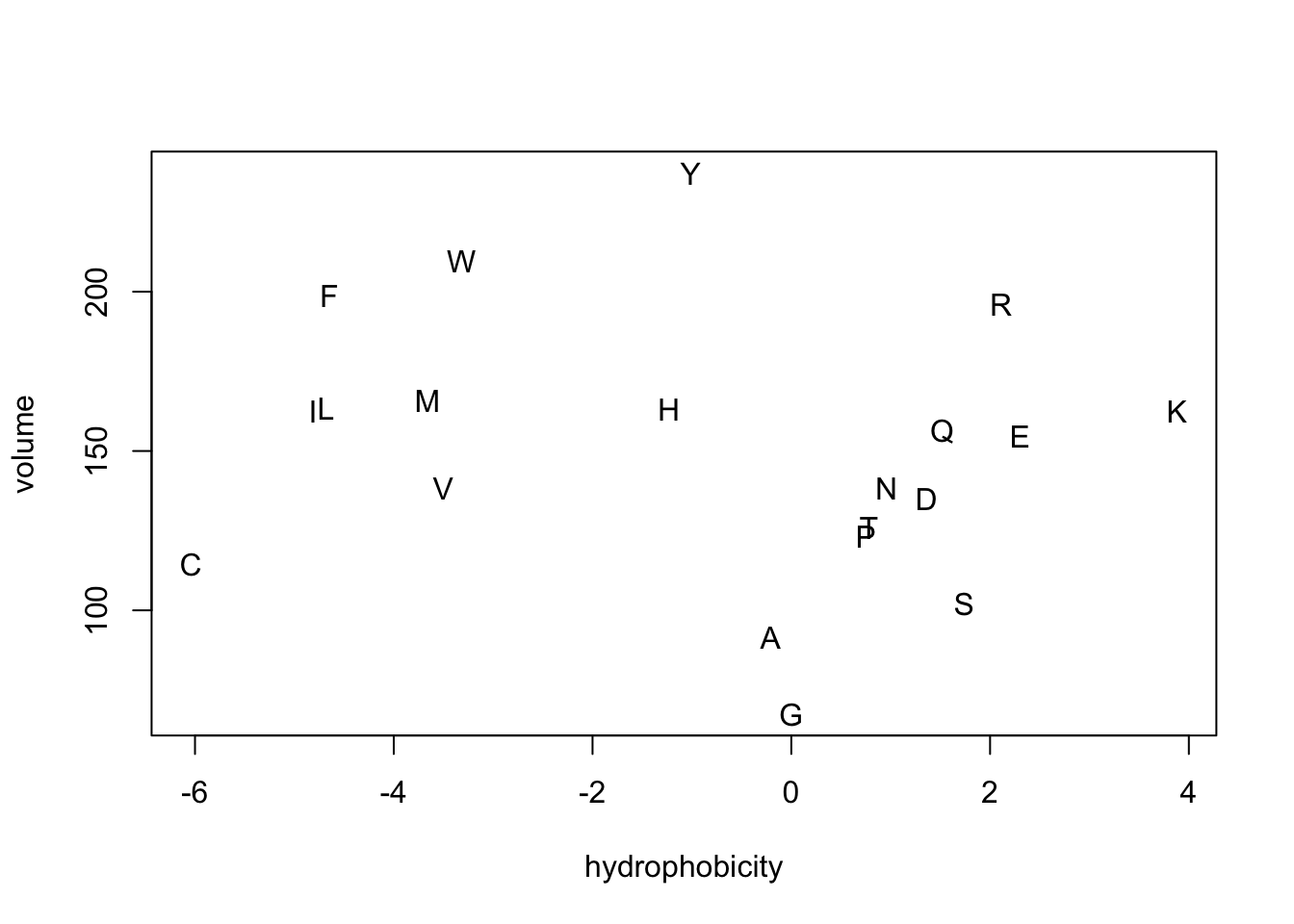
- Now, just for fun, let's use seqinr package functions to download a sequence and calculate some statistics (however, not to digress too far, without further explanation at this point).
- Copy the code below and paste it into the R-console.
seqinr::choosebank("swissprot")
mySeq <- seqinr::query("mySeq", "N=MBP1_YEAST")
mbp1 <- seqinr::getSequence(mySeq)
seqinr::closebank()
x <- seqinr::AAstat(mbp1[[1]])
barplot(sort(x$Compo), cex.names = 0.6)We could have "loaded" the package with library(), and then used the functions without prefix. Less typing, but also less explicit.
library(seqinr)
choosebank("swissprot")
mySeq <- query("mySeq", "N=MBP1_YEAST")
mbp1 <- getSequence(mySeq)
closebank()
x <- AAstat(mbp1[[1]])
barplot(sort(x$Compo), cex.names = 0.6)In general we will be using the idiom with the package prefix throughout the course.
The function requireNamespace() is useful because it does not produce an error when a package has not been installed. It simply returns TRUE if successful or FALSE if not. Therefore one can use the following code idiom in R scripts to avoid downloading the package every time the script is called.
if (! requireNamespace("seqinr", quietly=TRUE)) {
install.packages("seqinr")
}You can get package information with the following commands:
library(help = seqinr) # basic informationbrowseVignettes("seqinr") # available vignettes## No vignettes found by browseVignettes("seqinr")data(package = "seqinr") # available datasets- Note that install.packages() takes a (quoted) string as its argument, but library() takes a variable name (without quotes). New users usually get this wrong :-)
- Note that the Bioconductor project has its own installation system, the Biocmanager::install() function. It is explained here.
- Note, just to mention it at this point: to install packages that are not on CRAN or Bioconductor, you need the devtools package.
2.11.2 Finding packages
One of the challenges of working with R is the overabundance of options. CRAN has over 10,000 packages and Bioconductor has over 1,300 more. How can you find ones that are useful to your work? There's actually a package to help you do that, the sos package on CRAN. Try this:
if (! requireNamespace("sos", quietly=TRUE)) {
install.packages("sos")
}
library(help = sos) # basic information
browseVignettes("sos") # available vignettes
sos::findFn("moving average")Or:
- Read a CRAN Task View for your area of interest
- or the Bioconductor Views;
- Search on "Metacran" ("regex" example here") ...
- or "MRAN" ("regex" example here", not that the results are not identical);
- and, as always, Google.
2.11.3 Self-evaluation
- Question 1 - What is the purpose of this code?
if (! requireNamespace("seqinr", quietly = TRUE)) {
install.packages("seqinr")
}Why not just use:
install.packages("seqinr")Answer: This code idiom is useful in scripts, to ensure a package is installed before we try to use its functions. If we would simply use install.packages("seqinr"), the package would be downloaded from CRAN every time the script is run. That would make our script slow, and require available internet access for the script to run.
In the code above, the package is downloaded only when requireNamespace() returns FALSE, which presumably means the package has not yet been downloaded.
2.11.4 Further reading, links and resources
- Wikipedia article on the R statistics environment and programming language
- The R project homepage
- The R Studio IDE
- CRAN–The Comprehensive R Archive Network
- The Bioconductor project homepage
- R bloggers
- Package finding strategies (Revolutions Analytics Blog)
- Intro to R packages (at DataCamp).
- "The Impressive Growth of R" (Stackoverflow Data Analytics Team Blog)
- Ten simple rules for biologists learning to program - Carey and Papin advise novice biologist programmers how to begin. Much of this paper resonates well with our Introduction to R learning units. Good context for a beginning, to get a sense of where we are going with this.
If in doubt, ask!
If anything about this learning unit is not clear to you, do not proceed blindly but ask for clarification. Post your question on the course mailing list: others are likely to have similar problems. Or send an email to your instructor.
Author: Boris Steipe boris.steipe@utoronto.ca
Created: 2017-08-05
Modified: 2019-01-07
Version: 1.1
Version history:
1.1 Change from require() to requireNamespace() and use
1.02 Maintenance
1.0.1 Removed mention of Sweave - obsolete, and broken link. Added mention of "literate programming".
1.0 Completed to first live version
0.1 Material collected from previous tutorial
2.11.5 Updated Revision history
| Revision | Author | Date | Message |
|---|---|---|---|
| 5152496 | Ruth Isserlin | 2019-12-25 | Fixed issue with task numbering because of a remove all elements call in the 2nd chapter |
| fab47ae | Ruth Isserlin | 2019-12-24 | initial check in of R basics book |
2.11.6 Footnotes:
and when you click on the arrow to the left, this will take you back to where you came from↩
Proportional fonts are for elegant document layout. Monospaced fonts are needed to properly align characters in columns. For code and sequences, we always use monospaced font.↩
[1] means: the following is the first (often only) element of a vector.↩
A "wrapper" program uses another program's functionality in its own context. RStudio is a wrapper for R since it does not duplicate R's functions, it runs the actual R in the background.↩